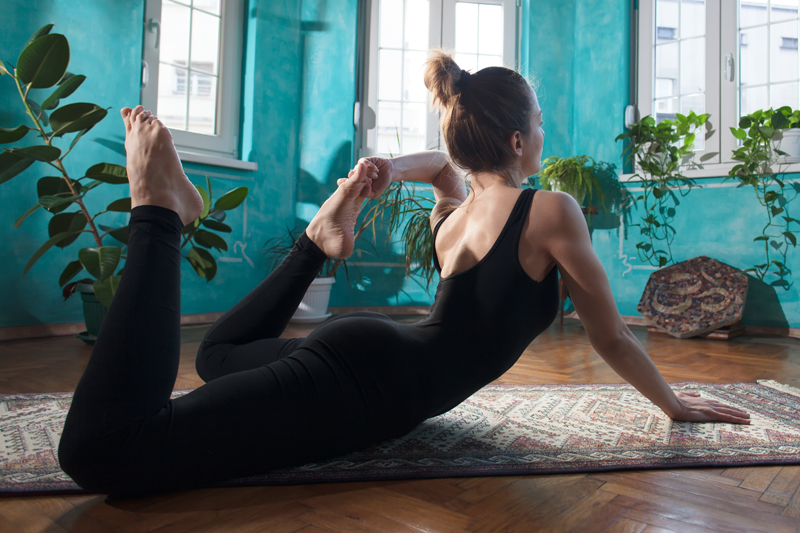
7 Ways You Could be Sabotaging Your Yoga Practice
January 23, 2020
This is the Guide to Yoga We Wish We Had Growing Up
February 6, 2020Establishing a Home Yoga Practice

There are numerous benefits to home yoga practice – you can practice anywhere, anytime, you can wear any yoga bra you like, and it’s a great complement to studio classes. It’s also pretty inexpensive, particularly if you do a self-guided practice with minimal equipment. Best of all, it allows you to practice yoga at your own pace in the comfort of your home. Before long, you’ll better understand what your body needs and practice in a way that supports you both physically and emotionally.
Wondering how to get started with practicing yoga at home? You’re in the right place. With this guide, establishing a home yoga practice will be easier than ever.
Get the Right Equipment
One of the best things about yoga is that you don’t need masses of equipment. However, a quality mat and a few props can benefit your alignment and make certain postures more comfortable. When yoga first came to the West, practitioners used towels or cotton mats to practice on. Foam or ‘sticky mats’ became popular in the 1980s and are still widely used today. Nowadays, the yoga accessories industry is huge and there is a wide range of mats available. Choosing a yoga mat that suits your needs will make your home practice more comfortable.
Find a Quiet Space
If possible, try to find a quiet and peaceful space to practice. It’s also helpful to have a wall nearby, but this isn’t essential. If you’ve got the space, you could turn a spare room into your home yoga studio. That way, you can leave your mat out throughout the week to encourage yourself to practice. Whether you’ve got a whole room or a space in the corner of your bedroom, fill the area with scented candles or incense to set the mood. You may also benefit from a photograph or quote that inspires your practice. The most important thing is that you’ve got the space to stretch out without bumping into walls, furniture, shelves, etc. Also, try to keep the space clean and tidy to promote a clean and tidy mind.
Commit to a Practice Schedule
To establish a home yoga practice, commit to a time and make it achievable. Consider what time works best for you. Maybe you’ve got time in the morning before heading to work, or maybe you’d prefer to wind down in the evening with a restorative sequence. If you work from home, you could even squeeze in a quick sequence during your lunch break! In terms of how long to practice for, choose a duration that suits you. Don’t worry about how long your friends are spending on the mat, or what you believe constitutes as a ‘proper’ yoga session. Instead, go with what works best for you. If you’re strapped for time, start by committing to just 10 minutes per day. Over the next few weeks, you can increase or decrease this as needed. The key to consistent practice is choosing a time that fits in with your life. If you don’t, it will be harder to maintain it.

Watch Out for Pain, Pinching and Pushing
Just like you would in a yoga class, watch out for the three P’s when establishing a home yoga practice. Listen to your body and avoid pain, pinching and pushing. If you’re a beginner, it can be hard to tell the difference between pain and discomfort. For the most part, discomfort is a dull, nagging sensation while pain feels hot and sharp. If you feel discomfort, you can usually work through it or soften or adjust your form. If you feel pain, particularly in the spine, knees, hips or neck, stop the posture and take a break. Instead of moving suddenly out of the posture, move gently. To avoid pain and discomfort, remember to warm up properly before using advanced postures.
Plan Ahead
To establish a home yoga practice, it’s important to plan ahead. If you’re doing an online class, decide which class you want to do the day before, so you don’t waste time when you get on the mat. This is particularly important if you’re stretched for time, as decision-making can be a lengthy process when you’re tired or stressed. You could even set up the class on your tablet the night before, so all you need to do in the morning is press play.
Listen to Your Body
When establishing a home yoga practice, the most important thing to do is to follow your body’s lead. If you’re used to following an online class, consider turning off your tablet and doing your own thing. At first, this can feel daunting. However, it’s a great way to deepen your mind-body connection and listen to what your body is telling you. Obviously, this may not be possible if you’re new to yoga. If you’re a beginner, take the time to learn a few postures first and perfect your alignment. This way, you can practice independently without the risk of injury from incorrect form. Once you know what you’re doing, get on your mat and move around for a few minutes doing whatever pose feels nice for your body. If you’d prefer, you could even take a few minutes to just sit quietly and reflect on your day. If you enjoy ‘freeform’ practice, start to add it to the end of your usual online class or sequence. Before Savasana, pause the video and take a few minutes to do your own thing. Once you’re done, you can restart it and enjoy the guided wind down.
In Summary
Establishing a home yoga practice is easier than you think. With the tips above, it won’t be long before you develop a consistent practice schedule that works for you and your family. If you suffer from restless sleeping, you may find it helpful to use a restorative sequence before bed. Simply roll out your mat, put on your coziest yoga hoodie, and work through your favorite postures. You can then head off to bed feeling relaxed and ready for sleep.

